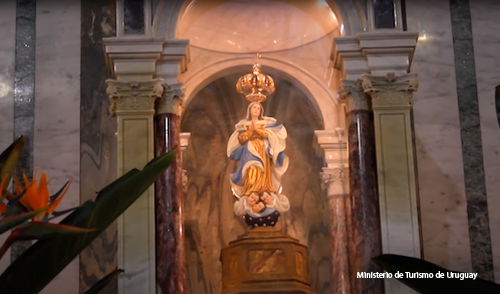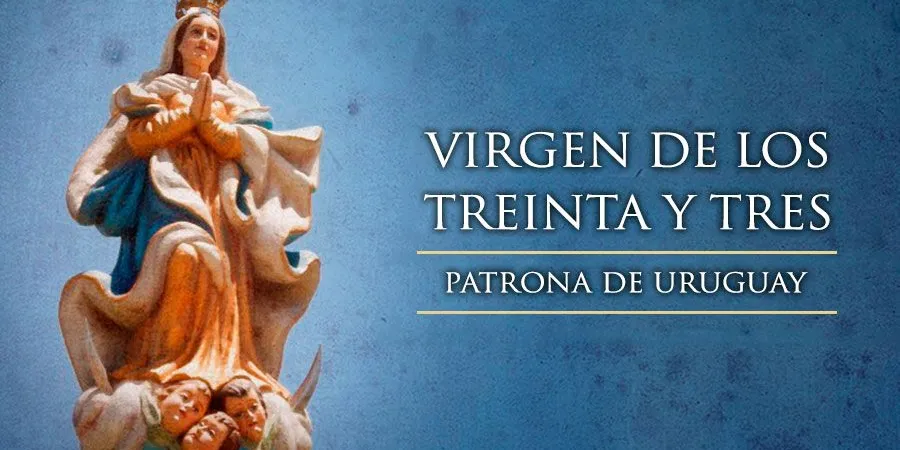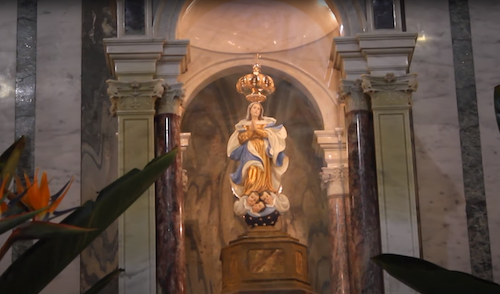Our Lady of the Thirty-three Patroness of Uruguay

Feast: Second Sunday of November
The small image of the Virgin of the Thirty-three is a wood carving from the workshops of the missions that the Jesuits had in Paraguay in the middle of the XVIII century. The image was made in one of the Guarani factories that flourished in these famous missions.
Around 1779 the image remained in the chapel that the Jesuit fathers attended in the town of Pintado and some time later, when the entire population moved to what is now the city of Florida, the neighbors took with them the beloved image before which their ancestors had prayed.
On April 19, 1825, thirty-three easterners, patriots from Uruguay, disembarked on the beaches of Agraciada to begin the wars of independence. When arriving at Florida they went to the small temple and at the feet of the Virgin they placed the future of the new nation.
On August 25 of that year the National Independence was proclaimed and the constituents, after signing the act of sovereignty, returned before the sacred image to place the nascent homeland under her protection. Since then the people called this image "La Virgen de los Treinta y Tres".
On August 25, 1975, on the 150th anniversary of its independence, the Uruguayan nation officially declared "Historical Monument" to this image of the Virgin and the temple where she is venerated.
The Virgin of the Treinta y Tres is 36 cm. high. It is a baroque carving of the Assumption of the Virgin, whose clothes seem to move in the wind by the abundance of its folds.
The "Liberator of Uruguay" has been wearing since 1857 a crown of gold and precious stones, a gift from the second chief of the Thirty-Three, who later became president of the Republic. The disproportionate size of this crown (an extraordinary work of goldsmithing) has become the distinctive feature of this Marian invocation.
The image was canonically crowned in 1961, by concession of His Holiness John XXIII, who the following year officially proclaimed her "Patroness of Uruguay". The solemnity of the Virgin of the Thirty-three is celebrated on the second Sunday of November with a pilgrimage to her sanctuary from all parts of the nation.La pequeña imagen de la Virgen de los Treinta y tres es una talla en madera procedente de los talleres de las misiones que los Jesuitas tenían en el Paraguay a mediados del siglo XVIII. La imagen fue confeccionada en alguna de las fábricas guaraníes que florecían en estas famosas misiones.
Hacia el 1779 la imagen permaneció en la capilla que los padres jesuitas atendían en el pueblo del Pintado y tiempo después, al trasladarse la población entera hacia lo que hoy es la ciudad de Florida, los vecinos llevaron consigo la querida imagen ante la que habían orado sus antepasados.
El 19 de abril de 1825, treinta y tres orientales, patriotas del Uruguay, desembarcaron en las playas de la Agraciada para dar comienzo a las guerras de independencia. Al llegar a Florida se dirigieron al pequeño templo y a los pies de la Virgen colocaron el futuro de la nueva nación.
El 25 de agosto de ese año se proclamó la Independencia Nacional y los constituyentes, después de firmar el acta de la soberanía, volvieron ante la sagrada imagen para colocar la patria naciente bajo su amparo y protección. Desde entonces el pueblo llamó a esta imagen "La Virgen de los Treinta y Tres".
El 25 de agosto de 1975, al cumplirse los 150 años de su independencia, la nación uruguaya declaró oficialmente "Monumento Histórico" a esta imagen de la Virgen y al templo donde se le venera.
La Virgen de los Treinta y Tres mide 36 cm. de alto. Es una talla barroca de la Asunción de la Virgen, cuyas vestiduras parece que se mueven al viento por la abundancia de sus pliegues.
La "Libertadora del Uruguay" porta desde 1857 una corona de oro y piedras preciosas, regalo del segundo jefe de los Treinta y Tres, que luego fuera presidente de la República. Lo desproporcionado del tamaño de esta corona (una extraordinaria obra de orfebrería) ha venido a ser la nota distintiva de esta advocación mariana.
La imagen fue coronada canónicamente en 1961, por concesión de Su Santidad Juan XXIII; quien al año siguiente la proclamó oficialmente "Patrona del Uruguay". La solemnidad de la Virgen de los Treinta y Tres se celebra el segundo domingo de noviembre con una peregrinación a su santuario desde todos los lugares de la nación.


